
making customer success simple
Certification Syllabus

The Practical CSM Academy Certification Syllabus
The Certification Syllabus for the Practical CSM Academy is based upon two core foundations:
Framework Based Learning and Real World Guidance:
Framework Based Learning
Real World Guidance
All four levels of the Practical CSM Academy’s certification program are
based on the Practical CSM Framework – a tried and tested best
practice model for the successful implementation of customer
success management.
The customer engagement is divided into seven phases, from
“Preparation” to “Engagement Evaluation”. Each phase provides
step-by-step best practice guidance in terms of both what to do at this
stage in the customer journey and how to do it in a way that
ensures the highest possible levels of both productivity and quality.
To determine what specific items should be taught and examined
and how much emphasis to place on each item is actually quite a
formidable task to accomplish.
In order to help makes these all-important decisions, the Practical CSM
Academy has created a panel of independent Customer Success
professional experts called the “Certification Oversight Committee”.
This panel provides guidance and steering for how the syllabus is
developed and adapted over time.

Ten Modules within Four Certification Levels
start point
Customer Success Fundamentals,
Business Fundamentals
Preparation, Commitment, Onboarding
Adoption Planning, Adoption Implementation,
Value Realization, Engagement Evaluation,
Putting it All Together
Certification Examination
The Certification program contains four certification levels – Specialist, Consultant, Expert and finally Certified CSM
Professional (CCSMP). Members undergo the training inside each of ten modules before progressing to the final exam.
Preparation, Commitment, Onboarding
Adoption Planning, Adoption Implementation,
Value Realization, Engagement Evaluation,
Putting it All Together
Certification Examination
The Certification program contains four certification levels – Specialist, Consultant, Expert and finally Certified CSM
Professional (CCSMP). Members undergo the training inside each of ten modules before progressing to the final exam.
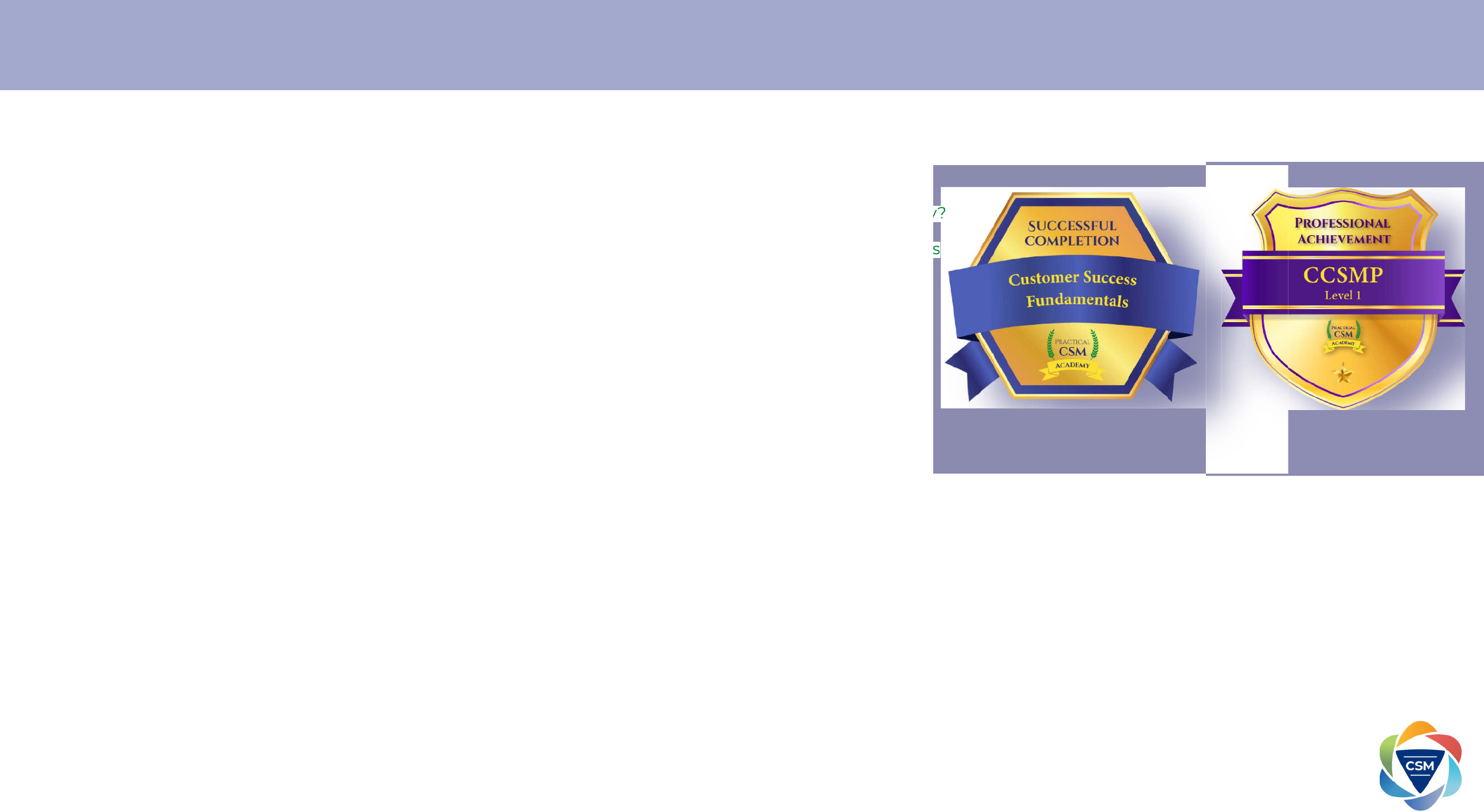
.
What is Customer Success and Why is it Important?
What is Customer Success Management?
Why Invest in Customer Success Management?
How Does Customer Success Work?
The Role of the Customer Success Manager
Understanding Outcomes and KPIs
Treating your Customer as your Business Partner
Is Customer Success the same as Customer
Happiness?
Why is Customer Success Management becoming
More Important?
How does Customer Success Management help to
Realize Business Value?
Where do CSMs fit within the Wider Organizational
Structure?
Customer Renewals and Retention/Churn
Customer Success in Different Business Types
Land and Expand Sales Motions
Syllabus for Module 1: Customer Success Fundamentals
.
.
.
.
.
.
.
.
.
.
.
.
.
.
.
.
.
.
.
.
.
Customer Lifetime Value (CLV)
Customer Advocacy
What is your organization’s customer success strategy?
What is your role in helping to fulfil your organization’s
customer success strategy?
What assets and resources are available to help you?
How will you plan and manage your time?
Internal evangelization of customer success
management
The RAPAE Task Model –
a way to categorize CSM activities
Research, Analysis and Planning as Enablers of Action
Understanding the Critical Path
Introducing The Practical CSM Framework
How should the Practical CSM Framework be used?
Getting in Front of Senior Management and ‘C’ Level
Customer Stakeholders
The 14 Tenets of Customer Success
Reflecting on your own knowledge, skills and experience
.
.
.
.
.
.
.
What is your organization’s customer success strategy?
What is your role in helping to fulfil your organization’s
What is your organization’s customer success strategy?
Module One provides a foundational
understanding of the basics of
Customer Success Management.
It defines what customer success is,
explains its value to both customers
and suppliers, and explains the core
components of the CSM’s role.
MODULE 1
LEVEL 1

.
What is meant by the term “business
fundamentals”
Why an understanding of business
fundamentals is essential to many (if not all)
customer success managers
Why businesses exist and how they fulfil
this purpose
How value is generated for the business’s owners
Who (besides owners) businesses generate value
for, and why this is important
How businesses calculate both their
expenditure and their profits in order to
generate an “annual return” statement
Understanding customer segmentation
Understanding value propositions
How customer segmentation relates to value
propositions
Syllabus for Module 2: Business Fundamentals
.
.
.
.
.
.
.
.
.
.
.
.
.
.
.
.
How businesses are structured and managed
Management Levels and Decision Making
A review of a typical company org chart
What is meant by the term “business capability”
How the concept of business capabilities can be
used to define and understand everything that a
business does
Why businesses are constantly needing to change,
with examples to illustrate how this works in real
life
Vision and strategy formulation and how it occurs
in a modern business
An overview of the BMM (Business Motivation
Model), including discussion on each component of
the BMM and how they come together to create
meaningful change within a business
.
Module Two delivers a grounding in
the fundamentals of how businesses
work and how they are managed.
This is essential knowledge for CSMs
who need to be able to empathize
with and help solve the problems of
their customers’ key business
decision makers.
MODULE 2
LEVEL 1
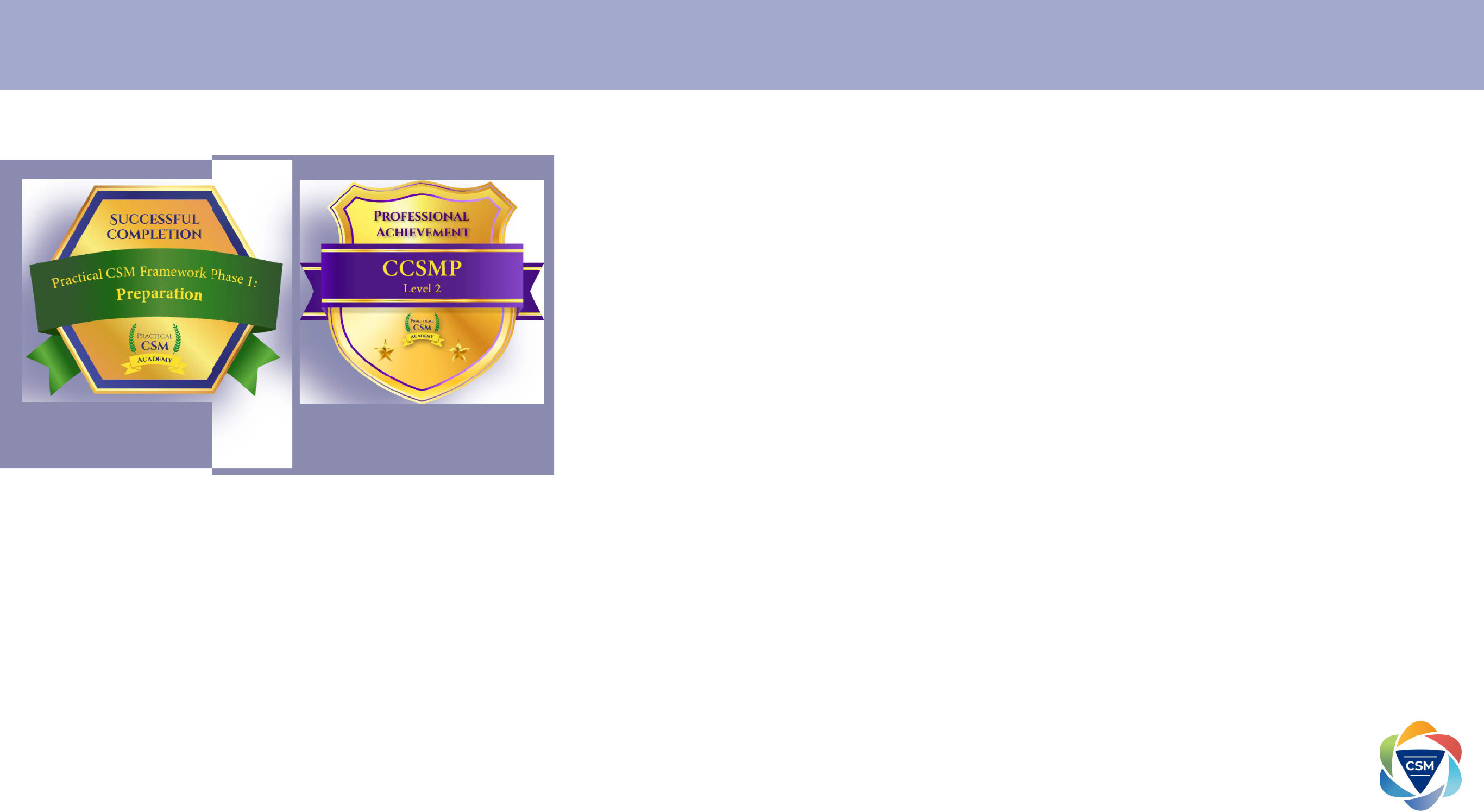
.
.
.
.
.
What is PCSMF Phase 1: Preparation all about?
Defining the customer engagement
Accessing information
Internal handover
Customer information
Solution information
Initiative information and customer outcome
requirements
CSM outcome requirements
Stakeholder information
Third parties and project status
Managing information gaps
Formulating an engagement strategy and
roadmap
Tools for PCSMF Phase 1: Preparation
Providing a Joined Up Customer Experience
Sources for Researching Customer Information
Syllabus for
Module 3: Preparation
.
.
.
.
.
.
.
.
.
.
.
.
.
.
.
.
.
.
Selecting & Validating Customer Information
Information to Research
The Customer Research Checklist Tool: Overview
The Customer Research Checklist Tool: Customer
Tab
The Customer Research Checklist Tool: Solution Tab
The Customer Research Checklist Tool: Initiative Tab
The Customer Research Checklist Tool:
Stakeholders Tab
The Customer Research Checklist Tool: Progress Tab
The Customer Research Checklist Tool: Utilization
Engagement Planning & Engagement Strategy
Tool
Engagement Strategy: Priority, Complexity
& Maturity
Engagement Strategy: Outcomes, Milestones
& Measurements
Engagement Strategy: Activities & Roadmap
.
.
.
.
.
Module Three focuses specifically on
what CSMs should do to prepare
themselves before they engage with
a new customer. This all important
research and planning phase is a
part of what enables high quality
results later down the line.
MODULE 3
LEVEL 2

What is PCSMF Phase 2:
Commitment all about?
The customer commitment
process
Communicating with the
customer
The initial customer meeting
Developing a stakeholder
management strategy
Tools for PCSMF Phase 2:
Commitment
Working With the Customer:
Key Concepts
Syllabus for Module 4: Commitment
.
.
.
.
.
.
.
.
.
.
.
.
.
.
.
Working With the Customer:
Credibility & Rapport
The Customer Success Proposal
Meetings Best Practice
Consultative Questioning
Using the RACI Matrix
Using the Stakeholder
Management Matrix
Creating a Stakeholder
Management Plan
Completing the Customer Success
Proposal
Module Four explains key aspects
of relationship management, the
validation of information, educating
key stakeholders on the concepts
and value of customer success
management, and negotiating
and agreeing a success roadmap.
MODULE 4
LEVEL 2
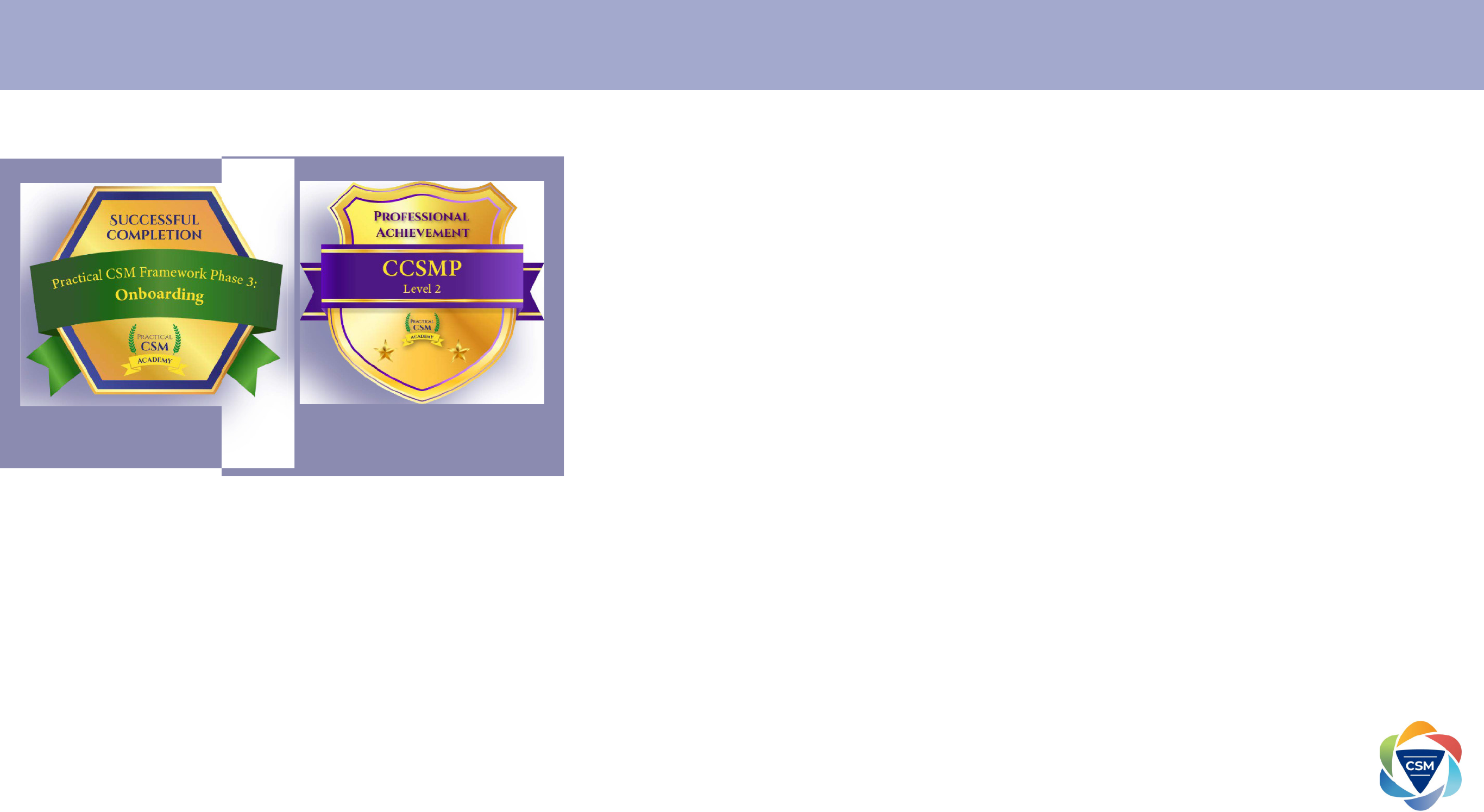
Syllabus for Module 5: Onboarding
.
.
.
.
.
.
.
.
.
.
.
.
.
.
.
.
.
.
.
.
.
Using a Customized Onboarding
Service Model
Onboarding Services at Your Company
Four Influencers of Onboarding
The Customer Onboarding Scoring
Matrix
Onboarding Discussions with the
Customer
Customized Onboarding and Full
Adoption Services
Three Choices for Onboarding:
Generic, Customized or Fully Bespoke
Information for Generic Onboarding
Information for Customized
Onboarding
Managing the Onboarding Process
Developing the Right Onboarding
Services
What is PCSMF Phase 3:
Onboarding all about?
Understanding onboarding
Generic and customized
onboarding models
Onboarding as a professional
service
Tools for PCSMF Phase 3:
Onboarding
What is “Onboarding”?
Why is Onboarding Important?
Onboarding Vs Adoption
Vs Value Realization
Selecting an Onboarding Service
Model
Using a Generic Onboarding
Service Model
Module Five defines how the CSM
delivers a comprehensive and high
quality onboarding experience to the
newly engaged customer. This
module identifies what should be
included within an onboarding
program and explains how to
deliver it.
MODULE 5
LE
VEL 2
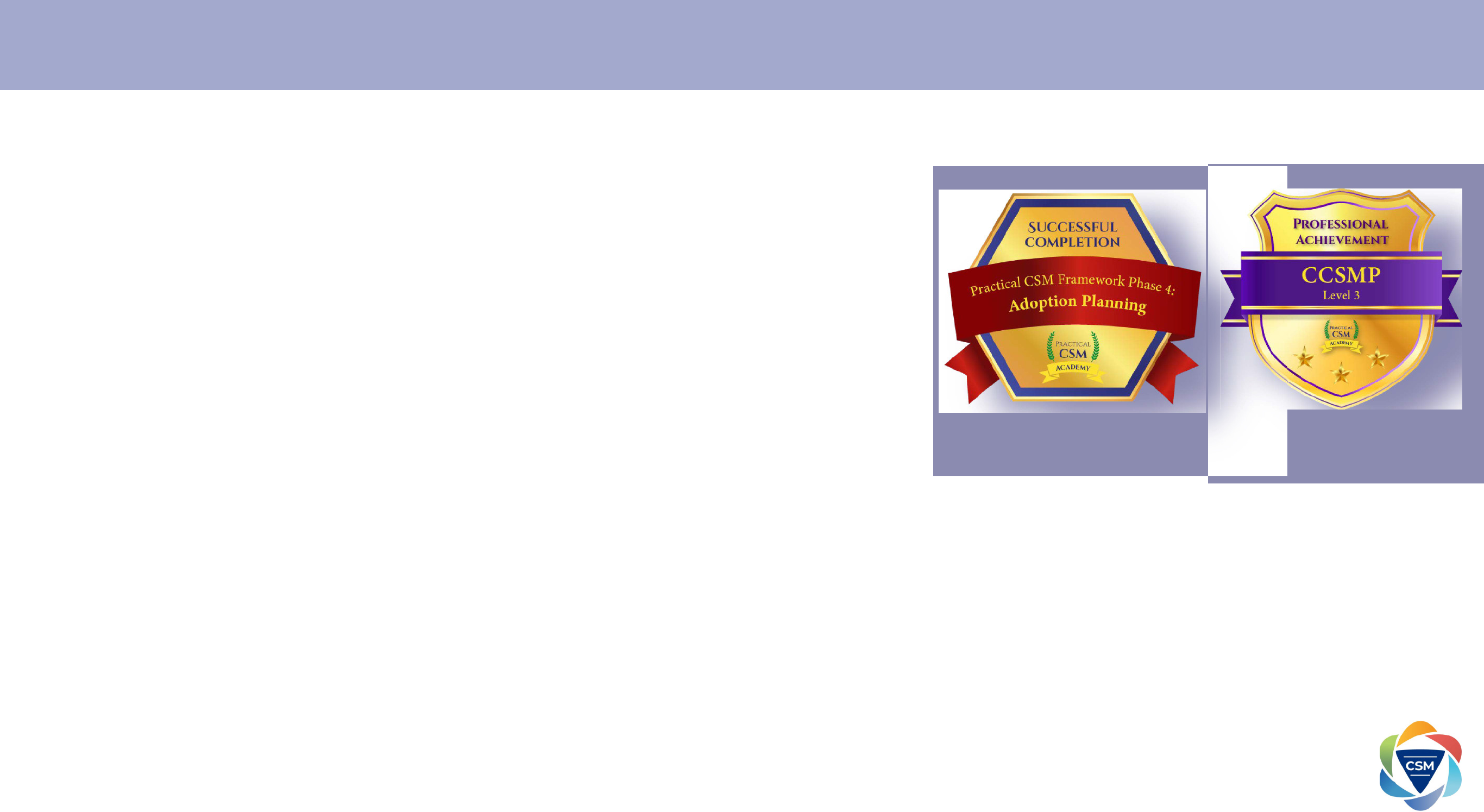
What is PCSMF Phase 4: Adoption Planning all
about?
Understanding Impacted Users
Research Techniques
CSM Involvement in Adoption Research
Working with multiple stakeholders
Step 1: Determine Adoption Requirements
Step 2: Identify Process Changes
Step 3: Define Impacted Groups (IGs)
Step 4: Document Practical Considerations
Step 5: Determine Communication, Training
and Support Requirements
Step 6: Capture Adoption Barriers and Risks
Step 7: Create Outline Adoption Plan
Step 8: Create Adoption Proposal and Gain
Acceptance
Step 9: Complete Full Adoption Plan and Publish
Adoption Roadmap
Activities and Outputs for PCSMF Phase 4:
Adoption Planning
Syllabus for Module 6: Adoption Planning
.
.
.
.
.
.
.
.
.
.
.
.
.
.
.
.
.
.
.
.
.
.
.
.
.
.
.
.
.
.
.
.
Defining Adoption & the Importance of Adoption
Adoption Pilots and Phases
Adoption and Change Management
The ADKAR Change Management Model
Knowledge Skills & Attitude (KSA) Concepts
Directly & Indirectly Impacted Users
Research Techniques: The Workshop
Getting the Adoption Requirements Agreed
The Role of the CSM in Adoption Planning
The Adoption Planning Process
Adoption Planning Tools: Existing Tools
Adoption Planning Tools: General Adoption
Requirements
Adoption Planning Tools: Capabilities & Processes
Adoption Planning Tools: Impacted Groups
Adoption Planning Tools: Adoption Activities
Adoption Planning Tools: Practical Considerations
Adoption Planning Tools: Adoption Barriers
Adoption Planning Tools: Adoption Risks
.
Module Six is the first of two modules
that concentrates on the adoption
process. In this module the focus is
on adoption planning, including
how to research and analyze
business requirements, business
capabilities and impacted users.
LEVEL 3
MODULE 6
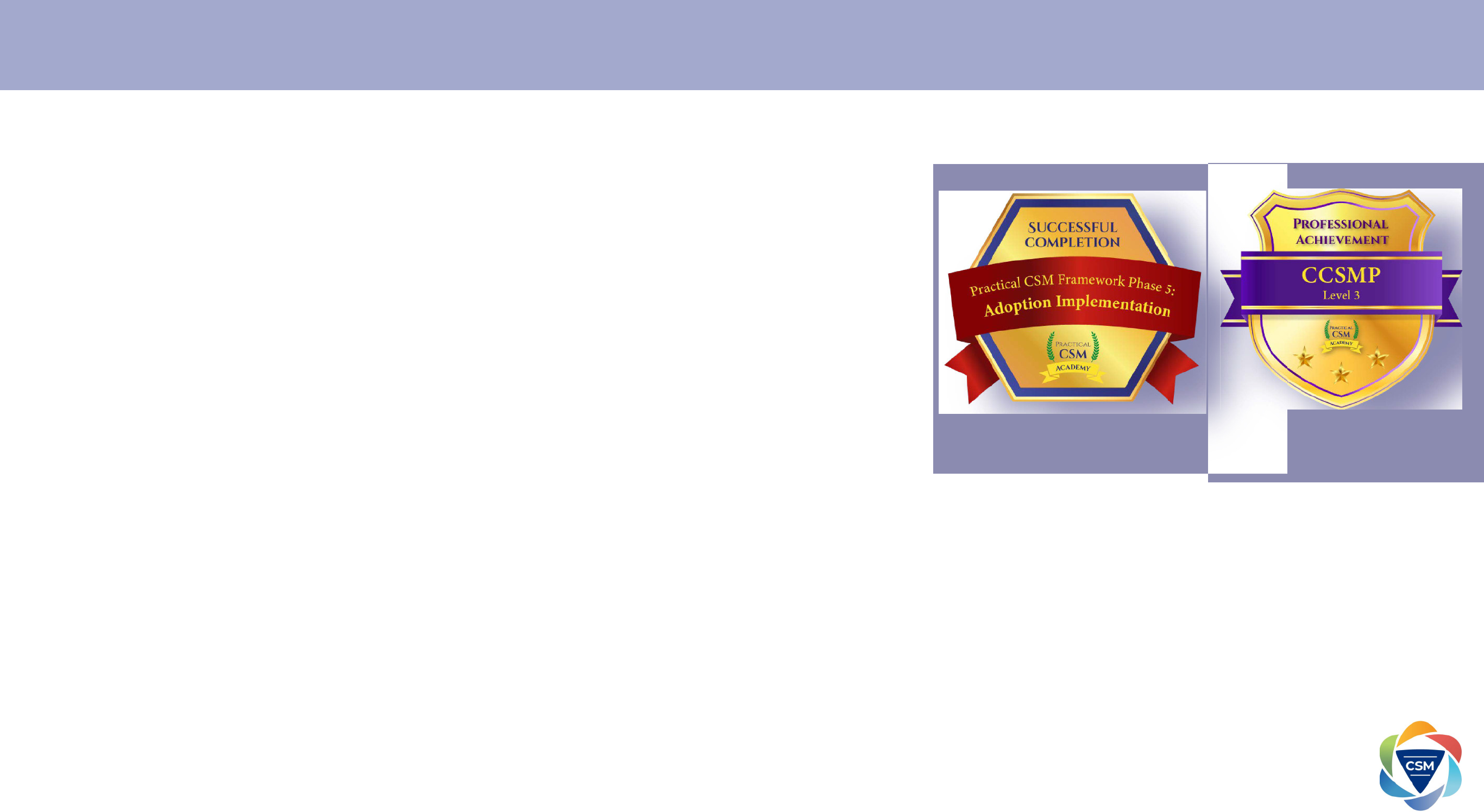
What is PCSMF Phase 5: Adoption
Implementation all about?
Project Management and the Role of the CSM
Benefits of a Multi-Phased Adoption Program
Preparing for Project Kick-Off
Managing People
Managing Tasks
Measuring and Reporting
Handling Problems
Dealing with Change
Completing the Project
Tools for PCSMF Phase 5: Adoption
Implementation
Activities and Outputs for PCSMF Phase 5:
Adoption Implementation
Adoption Implementation Roles
Project Management Principles &
Best Practices
Syllabus for Module 7: Adoption Implementation
.
.
.
.
.
.
.
.
.
.
.
.
.
.
.
.
.
.
.
.
.
.
Preparing for Project Kick-Off
Managing End User Conflict
Adoption Task Management
Work Breakdown Structure (WBS)
Understanding The Critical Path Method (CPM)
Using The Critical Path Method (CPM)
Applying WBS and CPM to an Adoption
Initiative
Adoption Activity Measurement & Reporting
Overview
Targets, Baselines and Milestones
Adoption Reporting
Handling Problems During Adoption
Problem Handling Best Practice Steps 1 to 6
Adoption Project Completion
Readiness for Value Realization
.
.
.
.
.
.
Module Seven completes the
discussion on adoption by explaining
how to use project management
and change management best
practices to help the customer
implement the adoption plan in
an efficient and effective manner.
LEVEL 3
MODULE 7
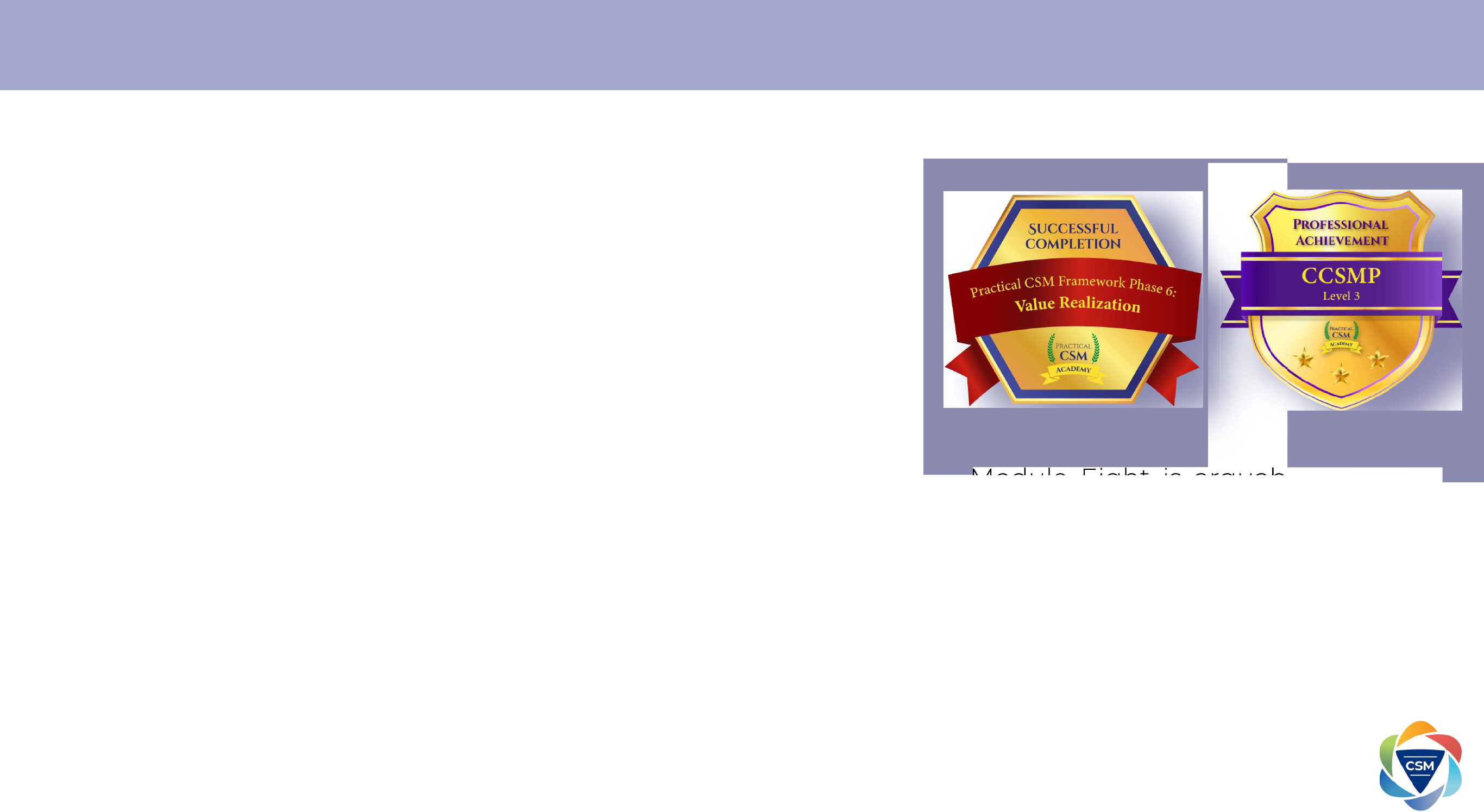
What is PCSMF Phase 6: Value Realization all
about?
Comparative Duration of the Value Realization
Phase
Balancing the Needs of Multiple Customers
Helping Customers to Realize Their Value
Maximizing Renewals
Upselling and Crosselling
Feedback and Advocacy
Has Everything Been Done?
Tools for Practical CSM Framework Phase 6: Value
Realization
Activities and Outputs for Practical CSM
Framework Phase 6: Value Realization
Promised and Anticipated Value
Determining the Value Generated ng
Selecting Key Performance Indicators (KPIs)
Problems With Value Realization
Where Does Value Come From?
Knowledge is Power
Progress Towards Outcome Attainment
Syllabus for Module 8: Value Realization
.
.
.
.
.
.
.
.
.
.
.
.
.
.
.
.
.
.
.
.
.
.
.
.
.
.
.
.
.
.
.
.
.
Steps in the Performance Management Process
Defining the Outcome Requirements and KPIs
If Stakeholders Don’t Know What They Want…
If Stakeholders Don’t Agree Between Them as to
What They Want…
Converting Indirect Value into Direct (Financial)
Value
Working to the Customer’s Agenda
Suppliers Need Customers to Remain as Customers
Realizing Value Vs Attaining Value
What is the Customer’s Agenda?
Problem Solving: What if the Value is Not Being
Attained?
What is Root Cause Analysis?
Root Cause Analysis Steps
Five “Why?”s and the Cause and Effect Diagram
The Role of the CSM in Sales Activities
Using Consultative Questioning to Determine
Outcome & KPI Requirements
Reporting on Progress Towards Outcome
Attainment
Reporting on the Financial Returns from
the Investment
.
Module Eight is arguably the most
important module of all as this
focuses on what the CSM needs to
do to ensure that the customer not
just attains but also realizes the
maximum value from the
implementation of the solution.
LEVEL 3
MODULE 8
Module Eight is arguably the most
Module Eight is arguably the most
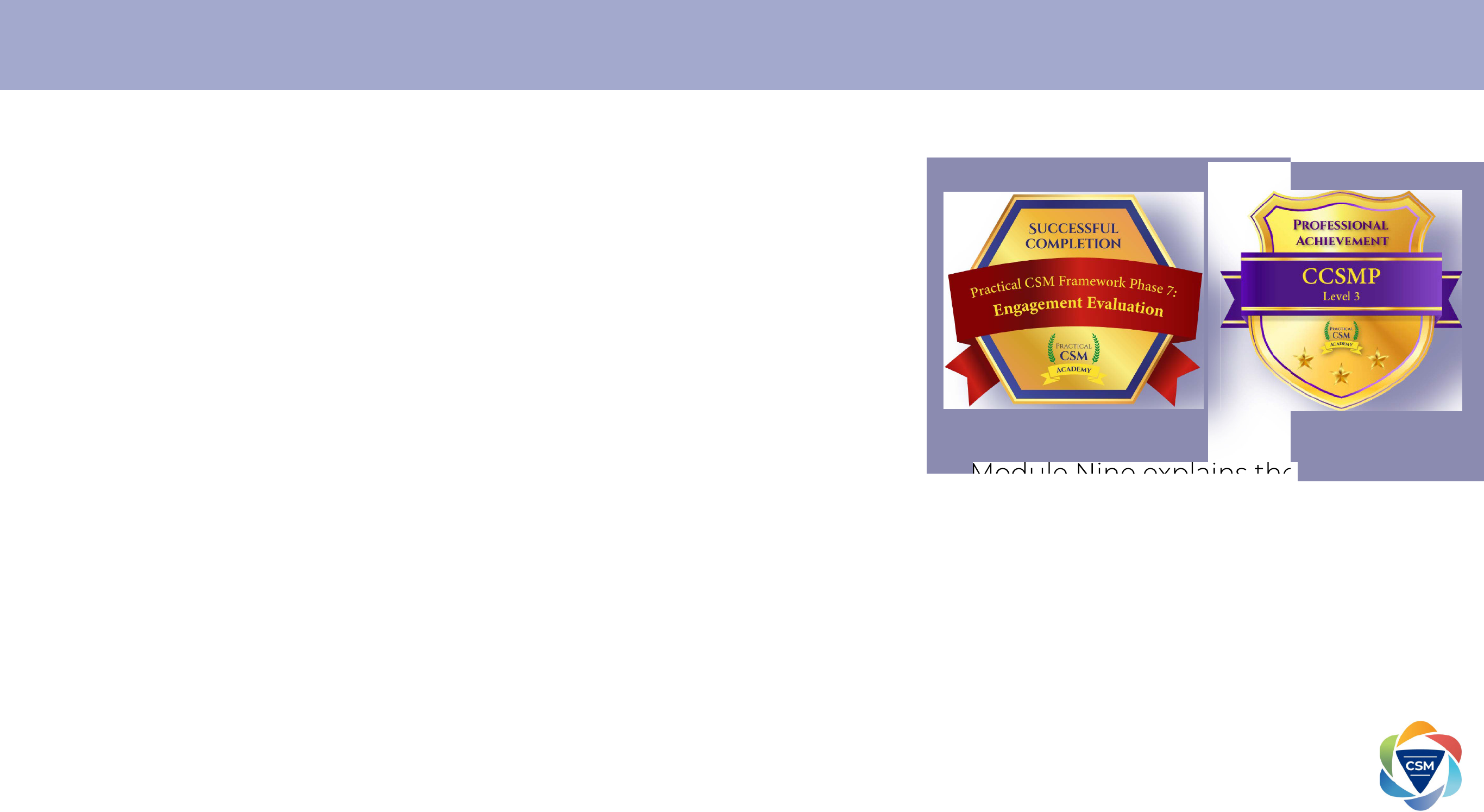
What is PCSMF Phase 7: Engage-
ment Evaluation all about?
The importance of reviewing CSM
activity
Increasing the customer success
management knowledge base
Updating personal and team best
practices
Templating common process steps
Improving your own CSM practice
Working with quarterly activity
targets
Improving your Team’s practice
Celebration of Success
Activities and Outputs for Practical
CSM Framework Phase 7:
Engagement Evaluation
Overview of the Executive Business
Review (EBR)
Syllabus for Module 9: Engagement Evaluation
.
.
.
.
.
.
.
.
.
.
.
.
.
.
.
.
Cadence & Attendees the Executive
Business Review
Structure of an Executive Business
Review
Executive Business Review Best
Practice
Getting Senior Stakeholders to Attend
What Value Has the Customer
Received From this Engagement?
What Value Has the Supplier Received
From this Engagement?
What Value Has the CSM Received
From this Engagement?
Using the Engagement Evaluation
Tool
Using the Personal Evaluation Tool
The Customer Success Roadmap
Example Customer Success Roadmap
.
.
.
.
.
.
Module Nine explains the
importance of evaluating progress at
every stage of the journey, and
describes how to document best
practice for efficient re-use and how
to identify areas for improvement of
the service for future engagements.
LEVEL 3
MODULE 9
What is PCSMF Phase 6: Value Realization all
about?
Comparative Duration of the Value Realization
Phase
Balancing the Needs of Multiple Customers
Helping Customers to Realize Their Value
Maximizing Renewals
Upselling and Crosselling
Feedback and Advocacy
Has Everything Been Done?
Tools for Practical CSM Framework Phase 6: Value
Realization
Activities and Outputs for Practical CSM
Framework Phase 6: Value Realization
Promised and Anticipated Value
Determining the Value Generated ng
Selecting Key Performance Indicators (KPIs)
Problems With Value Realization
Where Does Value Come From?
Knowledge is Power
Progress Towards Outcome Attainment
Steps in the Performance Management Process
Defining the Outcome Requirements and KPIs
If Stakeholders Don’t Know What They Want…
If Stakeholders Don’t Agree Between Them as to
What They Want…
Converting Indirect Value into Direct (Financial)
Value
Working to the Customer’s Agenda
Suppliers Need Customers to Remain as Customers
Realizing Value Vs Attaining Value
What is the Customer’s Agenda?
Problem Solving: What if the Value is Not Being
Attained?
What is Root Cause Analysis?
Root Cause Analysis Steps
Five “Why?”s and the Cause and Effect Diagram
The Role of the CSM in Sales Activities
Using Consultative Questioning to Determine
Outcome & KPI Requirements
Reporting on Progress Towards Outcome
Attainment
Reporting on the Financial Returns from
the Investment
Module Nine explains the
Module Nine explains the
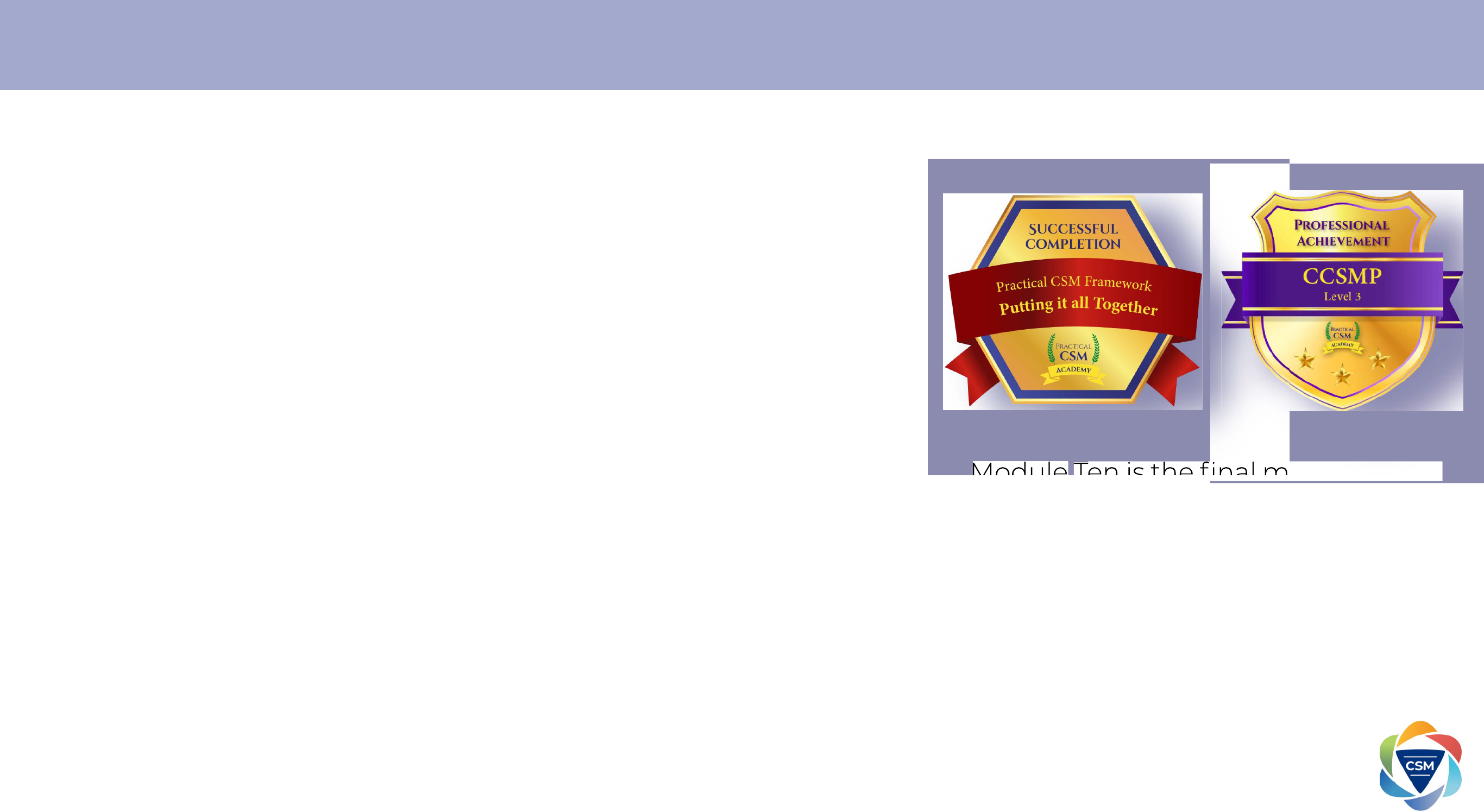
Who Benefits from Customer
Success Management?
Common CSM Traps and Pitfalls
Customer Success is the Jewel in
the Customer Experience Crown
The Future of Customer Success
Glossary of Essential Customer
Success Management Terminology
The Customer Success
Knowledgebase
Using a Best Practice Framework
Using Tools & Templates
Customer Success Management as
a Sales Feature
The Partnering Approach
The “Shared Risks, Shared Rewards”
Model
Syllabus for Module 10: Putting it All Together
.
.
.
.
.
.
.
.
.
.
.
.
.
.
.
.
Pitfall 1: Doing Too Much for
Each Customer
Pitfall 2: Not Leaving Time for
Continual Professional Development
(CPD)
Pitfall 3: Not Understanding Your Own
Company’s Customer Success
Strategy
Pitfall 4: Focusing on Technical Instead
of Business Issues
Pitfall 5: A Lack of Insight Into Your
Customer’s Business
Pitfall 6: Too Much Time Spent Doing
Admin
Pitfall 7: Lack of Best Practice
Resources Such as Frameworks, Tools
& Templates
.
.
Module Ten is the final module in the
series, and this module puts all seven
phases of the Practical CSM
Framework together into a single
context of an end-to-end customer
engagement, and discusses how to
improve the CS practice.
LEVEL 3
MODULE 10
Module
T
en is the final module in the
en is the final module in the
Ten is the final module in the T
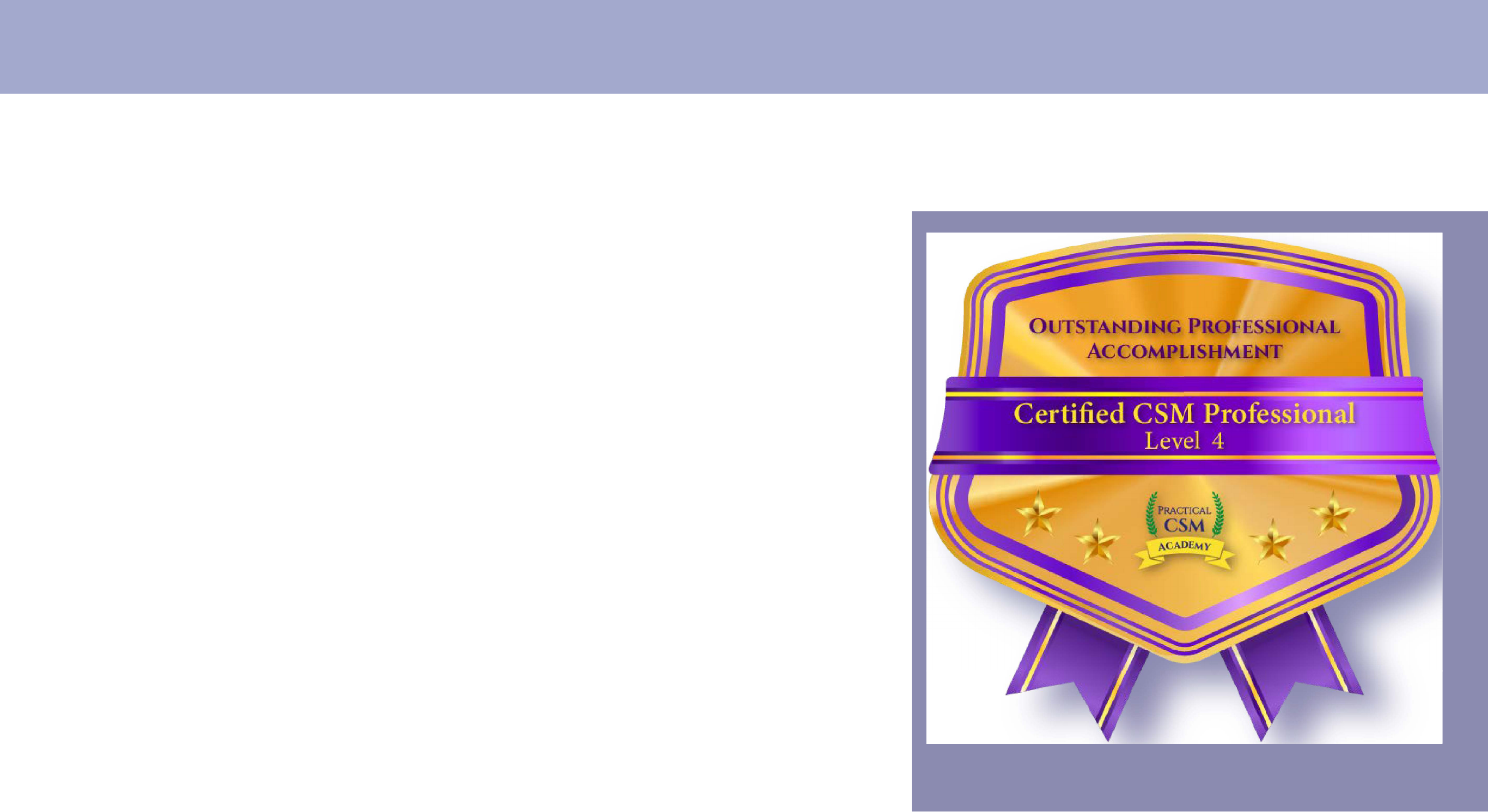
The Certified CSM Professional (CCSMP) Exam
LEVEL 4
Two Final Exams to Gain our Highest
Professional Certification
Our Certification Levels One, Two and Three each contain
respectively two, three and five training modules plus a simple
test at the end of each module.
Our Level Four Certification works somewhat differently. For this
level there is no further training requirement, instead the
candidate is expected to revise the content of all ten of the
previous training modules preparatory to taking a final, two part
exam.
Both exams are in an “open book” format that are taken online and
are timed. Part One comprises 50 simple questions that candidates
must answer within 60 minutes. Part Two comprises just eight,
more detailed “scenario” based questions for which candidates
receive 40 minutes to answer. Part One is designed to test
knowledge, and Part Two is designed to test a candidate’s abilities
to apply that knowledge to real world challenges.

Certification Oversight Committee
The Certified CSM Professional syllabus is based on the Practical CSM Framework, and it is overseen by our Certification Oversight Committee
of twelve independent Customer Success profession leaders and subject matter experts, plus our own Founder and CEO Rick Adams.
The training content for all ten training modules as well as all of the questions for the tests at the end of each module, and all of the questions for
both parts of the final, two part exam for attaining CCSMP status are all based on the syllabus.
The committee’s role is to review the syllabus on a regular basis and agree additions and amendments to ensure it always stays fresh, up to date
and relevant to the current needs of the CS profession. Changes to the syllabus are made by a majority decision within the committee, and are then
passed through to the content development team. The content development team then make the appropriate changes to the content (including
training materials and test/exam questions), and these are then published in due course for members to access.
Rick Adams
Founder & CEO PracticalCSM.com
Jared Raftery
Director, Cloud & Managed
Services Juniper Networks
Irit Eizips
Chief Customer Officer &
CEO CSM Practice
Jason Noble
VP Global Customer
Success Vinli Inc
Jeff Sheehan
CX Consultant
Independent Practice
Maranda Dziekonski
VP Customer Success
Swiftly Inc
Kristi Faltorusso
VP Customer Success
InteliShift Technologies LLC
Rav Dhaliwal
Investor & Venture Partner
Crane Venture Partners
Alan Fecamp
Director SaaS Recruitment
PIE Recruitment
Scott Morgan
VP Customer Success
Strategy PracticalCSM.com
Peter Armaly
Senior Director CS Strategy
Oracle
Sarah Bierenbaum
Founder & Principal
Sarah B Consulting
Heather Thompson
Manager, Customer
Success EMEA, HubSpot
practicalcsm.com/oversight-committee

making customer success simple
The Practical CSM Academy
practicalcsm.com/academy
